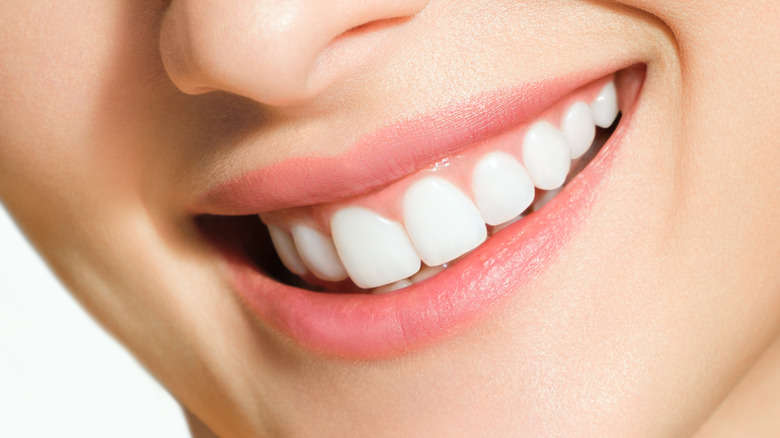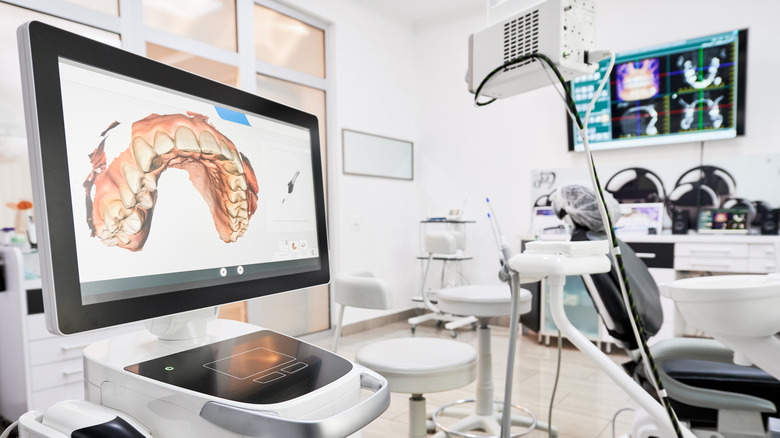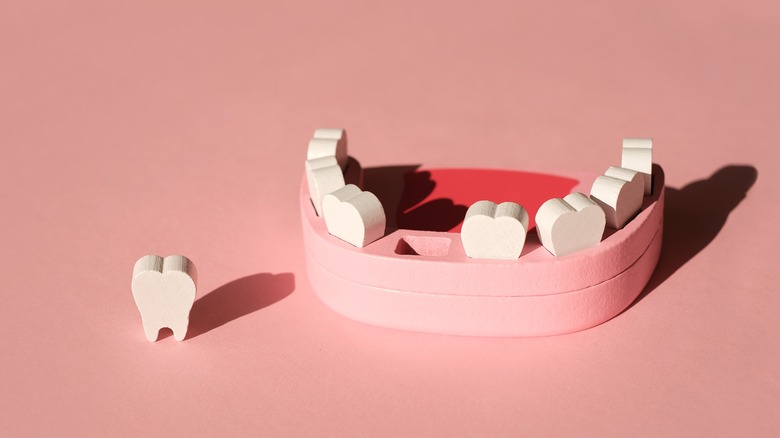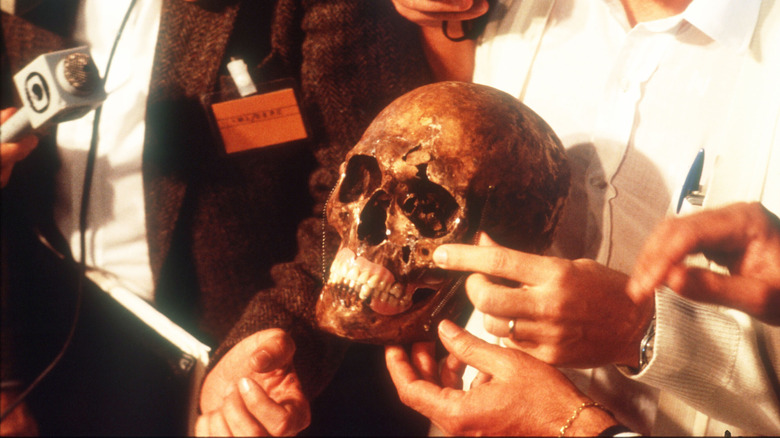How Police Use Dental Records To Identify A Body
In April 2009, 17-year-old Brittanee Drexel vanished while she was on vacation in Myrtle Beach, South Carolina (via CNN). Thirteen years later, the New York Post writes, her remains were found buried in Georgetown County, not far from where she was last seen. A suspect, Raymond Moody, has now been charged with Drexel's murder (per People). Spectrum News reports that the remains were found close to Moody's residence. Authorities then used DNA and dental records to confirm that the remains belonged to Drexel.
According to HowStuffWorks, forensic dentistry, also known as forensic odontology (per University of Maryland School of Dentistry), has been around since ancient Roman times. An article in the International Journal of Biomedical Science (posted at the National Library of Medicine) explains that forensic dentistry involves using dental evidence to positively identify victims of crimes or mass disasters. Authorities turn to this method when an individual's remains are too decomposed, burned, or mutilated for visual identification. Beyond this, forensic dentistry can also analyze DNA, create facial reconstructions, and provide the estimated age and gender of a victim. Controversially, bite marks have been used to identify perpetrators of a crime (via The Innocence Project). However, many discredit the use of this evidence as it has been deemed to be inaccurate in several cases. Nonetheless, forensic dentistry has proven its significance in the American justice system.
This is what a forensic odontologist does
ExploreHealthCareers reports that for the most part, a forensic odontologist is considered to be a dentist who specializes in identifying human remains. In many cases, they witness an autopsy to take photos and X-rays of the victim's teeth. Sometimes the job entails assessing bite marks from humans or animals (via the American Academy of Forensic Sciences). Additionally, a forensic odontologist can be used in lawsuits regarding dental malpractice and other dental injuries. When it comes to identifying an individual, a coroner or medical examiner will seek their expertise. Ultimately, this may lead to the forensic odontologist being asked to testify or deliberate at a trial.
Forbes explains that the services of a forensic odontologist are usually needed when forensic scientists have the remains of an individual referred to as a PTB, or "presumed to be." In other words, the authorities believe that they know the identity of the remains. However, due to decomposition and other factors, they can't verify this without the use of dental records. From there, the family of the PTB is contacted to get their dental information. Their dentist, after signing a medical release, will then send over dental records and X-rays.
This is where a forensic odontologist comes in. They will then compare the remains with the dental records of the PTB. It's for this reason that ExploreHealthCareers writes that a forensic odontologist must be extremely detailed and focused. Forbes states that the name of a PTB is always needed. If not, a forensic odontologist will be unable to make the comparison.
Teeth remain long after a body has decayed
According to Forbes, forensic scientists will always try to use fingerprints as a means of identification first, as it is a quick and easy process. Sometimes, this choice is simply not possible. The American Academy of Forensic Sciences explains that there is always the possibility that the victim doesn't have any previous records of fingerprints. In other cases, the victim's remains are either too decomposed or have been reduced to bones. Teeth, however, remain intact, even when the rest of the body is long gone, due to the extreme durability of the enamel (via HowStuffWorks). Furthermore, teeth can resist temperatures of 2,000 degrees Fahrenheit.
The International Journal of Biomedical Science states that even if they are exposed to extreme temperatures like this, the microstructure of teeth will remain intact. Per HowStuffWorks, the teeth will shrink and may become brittle, but can still be preserved for identification purposes. This is especially helpful when it comes to identifying victims who have died in fires and other disasters (per the University of Maryland School of Dentistry).
Per Richmond Dental and Medical, there are a plethora of methods that can be used besides comparing dental records to identify remains. Some of these include using DNA from tooth pulp or the mandibular bone. Additionally, a forensic odontologist can study the enamel rod (a substance that makes up teeth enamel) patterns of a tooth. Finally, there is always the possibility that the victim's teeth can be identified by loved ones as a result of distinct attributes like gold crowns and more (via HowStuffWorks).
Notable cases that have used forensic dentistry
Dental Products Report writes there have been numerous noteworthy cases that have used forensic odontology to identify victims and, in some cases, killers. One of the first instances in the United States was that of Dr. Joseph Warren. Per the New England Historical Society, Warren was a hero of the American Revolution, the one who sent Paul Revere on his midnight ride. He was also Revere's patient. Revere was an amateur dentist and had provided Warren with a false tooth. When Warren was killed during the Battle of Bunker Hill, Revere was able to identify his decomposed remains when he recognized the false tooth he had given him.
According to the University of Maryland School of Dentistry, a bite mark led to the conviction of serial killer Ted Bundy. Women's Health reports that in 1978, Bundy murdered Lisa Levy at the Chi Omega sorority house at Florida State University. Levy's left buttock had a bite mark that forensic odontologists concluded belonged to Bundy. Bundy had distinct crooked lower teeth that matched when compared to the bite on Levy's body. He was later sentenced to death and executed in January 1989 (via Dummies).
Known as the Angel of Death, Josef Mengele was a Nazi doctor who performed atrocious medical experiments on prisoners at the Auschwitz concentration camp. History explains that after World War II came to an end, Mengele fled to South America. He reportedly died in Brazil in 1979 while swimming. However, his death was not truly verified until dental records were used to prove the identity of his remains in 1985 (per United Press International).
Mass casualties and forensic dentistry
As The Conversation explains, one of the first actions taken after a mass disaster has occurred is the identification of remains. This is partly done to jumpstart the grieving process for the families and loved ones of victims. The American Academy of Forensic Sciences reports that these disasters can include tsunamis and hurricanes. Additionally, wars (per The Conversation), earthquakes, and train accidents can also be considered mass disasters (via the National Library of Medicine). In these cases, the names of the victims are not known. However, the hope is that they can be readily identified by using dental records.
The University of Maryland School of Dentistry states that forensic odontology was used to identify victims of the 2010 earthquake in Haiti and victims of tsunamis in both Japan and Thailand. Per another article from the National Library of Medicine, the remains of victims of the 2004 Indian Ocean tsunami disaster in Thailand were returned to relatives four months after the disaster occurred thanks to forensic odontology. Over 46% of identified individuals had dental records.
The U.S. Department of Justice's Office of Justice Programs writes that the tsunami in Thailand killed 5,500 people. This spurred a desperate call for forensic odontologists. Ultimately, forensic odontologists from over 30 countries helped in the identification process.
The controversy surrounding bite mark identification
HowStuffWorks reports that if a bite mark is found on a body, a forensic odontologist is dispatched to identify if it belongs to an animal or human. Moreover, this is done in a timely matter, as decomposition can alter the bite. The bite is also swabbed for DNA, measured, and photographed. Finally, the bite is cut from the body and preserved for evidence. The California Innocence Project writes that bite marks can be used in trials as evidence. In many instances, such as in Ted Bundy's case, it can lead to convictions. However, the Innocence Project states that using bite marks as evidence in criminal trials is nothing but pseudoscience.
The organization explains that 26 people have been wrongly convicted using bite mark evidence in the United States. The Innocence Project claims that people's teeth are not arranged uniquely. In other words, they should not and cannot be used to identify perpetrators. In 1992, David Krone was convicted of stabbing a woman to death from bite mark evidence (via the BBC). In 2002 (per The Innocence Project), Krone was freed when DNA found on the victim concluded that he was not the killer. He had been on death row for a decade, convicted of a crime he had not committed.





